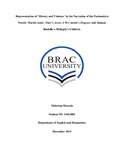| dc.contributor.advisor | Chowdhury, Rukhsana Rahim | |
| dc.contributor.author | Hossain, Mehruna | |
| dc.date.accessioned | 2016-02-10T12:47:24Z | |
| dc.date.available | 2016-02-10T12:47:24Z | |
| dc.date.copyright | 2015 | |
| dc.date.issued | 2015-12 | |
| dc.identifier.other | ID 14163001 | |
| dc.identifier.uri | http://hdl.handle.net/10361/4993 | |
| dc.description | This thesis is submitted in partial fulfillment of the requirements for the degree of Masters of Arts in English, 2015. | en_US |
| dc.description | Cataloged from PDF version of thesis. | |
| dc.description | Includes bibliographical references (page 43). | |
| dc.description.abstract | A novel cannot narrate time, experience or memory of the past accurately but can reconstruct history and then recount the events of history and violence. The literary devices and narrative techniques used to write history also have to be unusual to depict the past: especially the history which holds memory of war, colonization and destruction. Postmodernism proposes that history cannot be absolutely narrated as the authenticity and referent cannot be relied upon. So a subversive approach in the narrative technique—like non-linear narration, ironic representation, blending of history with fiction and magic-realism—are unconventional and postmodern approaches that can depict the violence and trauma of war, colonization, racism and displacement in writings or novels narrating history. Therefore this dissertation attempts to examine how history and violence are treated and depicted in three different postmodern novels, set in three different geographical contexts. The three novels Time’s Arrow, Midnight’s Children and Disgrace remarkably depict Nazi holocaust, India‘s history, tracing 30 years after Independence, and Post-Apartheid condition respectively. This paper will also explore how and why the postmodern techniques such as backward narration, use of magic realism, representation through irony are used in the novels to deconstruct the previous form of narrative techniques and to deal with serious themes and issues like war, colonization, displacement, racism and trauma. Finally the paper will examine and critique the representation of violence through the events in the novels. | en_US |
| dc.description.statementofresponsibility | Mehruna Hossain | |
| dc.format.extent | 43 pages | |
| dc.language.iso | en | en_US |
| dc.publisher | BRAC University | en_US |
| dc.rights | BRAC University thesis are protected by copyright. They may be viewed from this source for any purpose, but reproduction or distribution in any format is prohibited without written permission. | |
| dc.subject | English and humanities | en_US |
| dc.subject | History and violence | en_US |
| dc.subject | Postmodern novels | en_US |
| dc.title | Representation of ‘History and Violence’ in the narration of the postmodern novels : Martin Amis’ Time’s Arrow, J M Coetzee’s Disgrace and Salman Rushdie’s Midnight’s Children | en_US |
| dc.type | Thesis | en_US |
| dc.contributor.department | Department of English and Humanities, BRAC University | |
| dc.description.degree | M.A. in English | |

